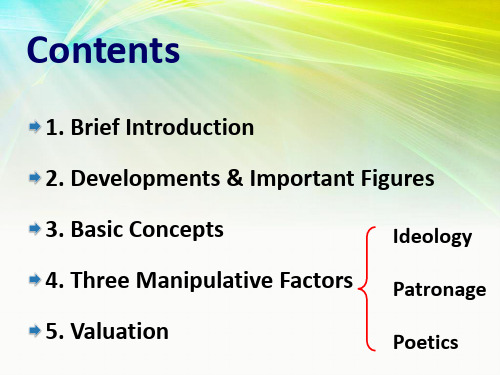操纵论ppt
- 格式:ppt
- 大小:5.98 MB
- 文档页数:40



Shanghai Jiao Tong University2nd Semester,Academic Year2014-2015 Summary of Ship Manoeuvrability for ReviewProf. Dr.-Ing. Zou ZaojianMay 14, 2015Outline●Introduction●Evaluation and Prediction of Ship Manoeuvrability ●Equations of Ship Manoeuvring Motion●Dynamic Stability of Ships●Initial Turning and Turning Ability of Ships●Control Devices●Measures to Improve Ship Manoeuvrability●Some Remarks on the ExaminationIntroduction●Purpose of the course-to answer the questions:What is “ship manoeuvrability” (What does “shipmanoeuvrability” deal with) ?Why should a ship have good manoeuvrability?How to evaluate ship manoeuvrability(How tomake judgement if a ship has good or poormanoeuvrability) ?How to ensure that a ship is designed/built withgood manoeuvrability(If a ship has poormanoeuvrability, or the manoeuvrability is notgood enough, how to take measures to improve itsmanoeuvrability) ?●Ship Manoeuvrability and Its Contents-Manoeuvrability: The ability of a ship to keep or change its state of motion under control actions according to the intention of the helmsman.Ship manoeuvrability includes : (definition)Inherent dynamic stability (straight line stability) Course-keeping ability (directional stability)Initial turning/course-changing abilityYaw-checking abilityTurning abilityStopping ability●Importance of Ship Manoeuvrability-Navigation safety(examples)-Navigation economy(examples)●Factors which affect navigation safety(1)Ship manoeuvrability itself(2)Human factors (most important !)(3)Environmental factors (wind, waves, current;restricted waters; etc.)●Closed-loop Control System for Ship ManoeuvringShip ↔Helmsman (Pilot or autopilot) ↔Control Devices ↔Environmental effects ↔ShipEvaluation of Ship Manoeuvrability●Standard manoeuvres and the parameters forevaluating ship manoeuvrability-How to conduct these manoeuvres?-The parameters obtained from these manoeuvres?-How can these parameters be used to evaluate ship manoeuvrability?Turning testZig-zag testStopping test (crash stop test)Spiral test (direct spiral and reverse spiral test)Pull-out testEvaluation of Ship Manoeuvrability(continued)●IMO Standards for Ship Manoeuvrability-Turning ability (with turning test)-Initial turning ability (with zig-zag test)-Yaw-checking and course-keeping abilities (with zig-zag test)-Stopping ability (with stopping test)●Full-scale TrialConduct the standard manoeuvres with full-scale ship to obtain the parameters for evaluating shipmanoeuvrabilityPrediction of Ship ManoeuvrabilityThe methods which can be used for predicting ship manoeuvrability at the ship design stage:(1) Empirical method (database, empirical formulae for theparameters for evaluating ship manoeuvrability)(2)Free-running model tests(by conducting the standardmanoeuvres with ship model)(3) Mathematical models(Equations of ship manoeuvringmotion) +computer simulation (simulation of thestandard manoeuvres)(4) Direct numerical simulation of the standard manoeuvresby using CFD (Computational Fluid Dynamics) techniques The second one and the third one are the most commonly used methods for predicting ship manoeuvrability at the ship design stage.Equations of Ship Manoeuvring MotionMathematical models (Equations of ship manoeuvring motion)-Coordinate systems(1) earth-fixed coordinate system(2) body-fixed coordinate system with the originlying on the center of gravity of the ship(3) body-fixed coordinate system with the originlying on the midship section-How to derive the equations of ship manoeuvring motion in these coordinate systems?Equations of Ship Manoeuvring Motion (continued)Expressions of the hydrodynamic forces in the equations of ship manoeuvring motion-Abkowitz model(MIT professor, whole-ship model)(1) The hydrodynamic force (and moment) actingon hull-propeller-rudder system as a whole(2) The hydrodynamic force (and moment) expressedby Taylor expansion, with the steady forwardmotion state as the expansion point-MMG model(Japanese mathematical modelling group, modular model)The hydrodynamic force (and moment) are dividedinto three parts: on hull, on propeller and on rudder, with the hydrodynamic interactions among thembeing taken into account.(continued)Methods for determining the hydrodynamic forces acting on a manoeuvring ship(1)Captive model tests (How are these tests conducted?)-Oblique-towing test-Rudder force test-Rotating-arm test-PMM test (pure sway, pure yaw tests, etc.)-Circular Motion Test(2)Semi-empirical method (database, empirical formulae, etc.)(3)System identification by analyzing the test results of free-running model tests or full-scale trials (4)Numerical method (Calculation)(continued)●Equations of ship manoeuvring motion (based onAbkowitz model)●Linearizationunder the assumption of small manoeuvring motion =>neglecting the high-order terms in the Taylorexpansion of the hydrodynamic force (and moment) => linear equations of ship manoeuvring motion●Linear hydrodynamic derivativesSome hydrodynamic derivatives are zero. Why?How to analyze the magnitude and the positive ornegative sign of the hydrodynamic derivatives?(continued)●Second-order response models derived from thelinear equations of ship manoeuvring motion-How to derive the response models from the linear equations of ship manoeuvring motion?-Response model: yaw motion as response to the rudder action; lateral motion as response to therudder action-Forms of the second-order response models-Coefficients and the manoeuvrability indexes in these models●First-order response model (Nomoto model)-Manoeuvrability indexes K、T in Nomoto model (Their relationship with ship manoeuvrability)Dynamic Stability of Ships●Categories of dynamic stability associated with ship manoeuvring (different kinds of stability)●Analysis of inherent dynamic stability (by using the response model without control action)●The criterion for inherent dynamic stability How to compare the inherent dynamic stability of ships with different C index?How to judge if a ship is dynamically stable or unstable? (How many methods are available? )()()0v Gr v r C Y m x N N m Y ''''''''=--+->Initial Turning and Turning Ability of Ships●Analysis of the initial turning and turning abilityof ships (by using the linear equations of shipmanoeuvring motion)●Three phases of the turning testRudder-turning phase (first phase)How to analyze the initial turning ability?Steady turning phase (third phase)How to analyze the turning ability?How to analyze the relationship between the K, C indexes and ship manoeuvrability, according to the formula of the steady yaw rate or the steady turning diameter ?The dynamic stability and the turning ability of a ship are usually in contradiction with each other. Why?Concomitant Phenomena during Turning Motion●Speed drop and heeling during turning motionSpeed droplarger resistance + lower propulsive efficiency=> speed drop (may be as large as 50%)HeelingThe heights of the acting points of the lateral forces acting on the rudder and on the hull are different,which produces a moment (heeling moment) about the longitudinal axis.During the different phases (e.g., first phase and third phase) of the turning test, different heeling moment, thus different heeling angle, will be induced.Control DevicesKinds of Control DevicesActive control deviceslateral thruster, azimuthing rudder propeller,steering nozzle, etc.Passive control devicesRudder: conventional/unconventional ruddersUnconventional rudders: rotating cylinder rudder, flap rudder, etc.Geometrical and performance characteristics, advantages and disadvantages of the active andpassive control devicesMeasures to Improve Ship ManoeuvrabilityAccording to the linear hydrodynamic derivatives involved in the expressions of the indexes K, T, and C, to analyze the effects of ship form on ship manoeuvrability, and to find out how to improve ship manoeuvrability(dynamic stability, turning ability, etc.).Some Remarks on the Examination●Type of the written examination—Judge if a statement is true or false:10%;—Fill in the blank:10%;—Comprehensive question (to describe briefly, to analyze, etc.):20%;—Calculation:10%。


